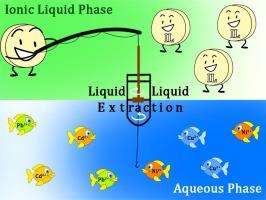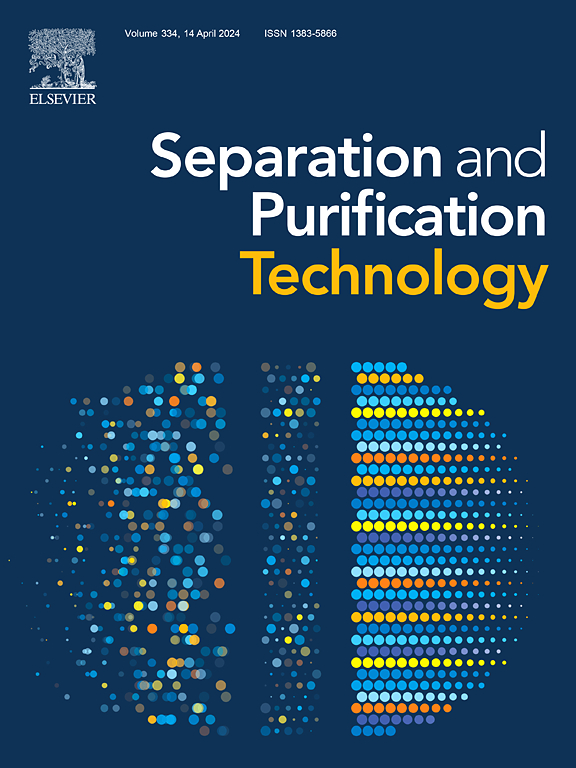利用基于三辛基铵羧酸盐离子液体的循环液液萃取技术有效去除废水中的多种重金属离子
IF 9
1区 工程技术
Q1 ENGINEERING, CHEMICAL
引用次数: 0
摘要
由于重金属离子(HMIs)的有害影响,各行各业普遍向自然水体排放含有重金属离子(HMIs)的污水,这已成为一个令人担忧的问题。最近,离子液体(IL)辅助液液萃取(LLE)已成为一种快速、简便的处理工业废水的方法,可有效降低二次污染的风险。本研究的主要目的是设计新型疏水性离子液体,用于从水介质中萃取去除有毒的 HMIs。通过将环状羧酸(硫代苯甲酸、吡啶二羧酸和嘧啶二羧酸)与三辛胺结合,设计出了这些疏水型 IL。目的是评估环状羧酸中不同配位原子对 HMI 提取的影响,而选择三辛胺则是为了提供必要的疏水性。在模拟工业条件下,评估了合成的 ILs 在单独萃取和从混合物中萃取去除有毒 HMIs(包括 Cu(II)、Cd(II)、Ni(II)和 Pb(II))方面的效率。为确定影响萃取效率的关键参数,进行了彻底的优化。为了确保实时适用性,将 HMI 浓度调整到了其报告的最大污染限值,在这些条件下,ILs 成功地实现了萃取。实验研究表明,即使在混合物中,ILs 也能有效地去除 HMIs,这证实了它们的实用性。与文献数据的详细对比显示,萃取机理主要依赖于金属的优先配位,遵循了 HSAB 原理。此外,使用乙二胺四乙酸二钠溶液可将金属离子剥离出来,从而促进了惰性离子的再生,实现了多次重复利用,支持了可持续的循环工艺。本文章由计算机程序翻译,如有差异,请以英文原文为准。

Effective elimination of multiple heavy metal ions from wastewater using circular liquid-liquid extraction based on trioctylammonium carboxylate ionic liquids
The widespread discharge of effluents containing heavy metal ions (HMIs) from various industries into natural water bodies has become an alarming concern due to their harmful effects. Recently, ionic liquid (IL)-assisted liquid–liquid extraction (LLE) has emerged as a rapid and facile method for treating industrial effluents, effectively reducing the risk of secondary pollution. The primary objective of this study was to design novel hydrophobic ILs for the extractive removal of toxic HMIs from aqueous media. These hydrophobic ILs were designed by incorporating cyclic carboxylic acids (thiobenzoic acid, pyridine dicarboxylic acid, and pyrimidine dicarboxylic acid) with trioctylamine. The aim was to evaluate the effect of different coordinating atoms in the cyclic carboxylic acids on HMI extraction, while the trioctylamine moiety was chosen to provide the necessary hydrophobicity. The synthesized ILs were evaluated for their efficiency in the extractive removal of toxic HMIs, including Cu(II), Cd(II), Ni(II), and Pb(II), both individually and from their mixtures, under simulated industrial conditions. Thorough optimization was performed to identify the key parameters affecting extraction efficiency. The HMI concentrations were adjusted to their reported maximum contamination limits to ensure real-time applicability, and the ILs demonstrated successful extraction under these conditions. Experimental studies showed that the ILs were able to effectively remove HMIs even from mixtures, confirming their practical relevance. A detailed comparison with literature data revealed that the extraction mechanism primarily relied on the preferential coordination of metals, following the HSAB principle. Furthermore, metal ions were stripped back using disodium EDTA solution, facilitating the regeneration of the ILs for multiple reuse cycles and supporting a sustainable, circular process.
求助全文
通过发布文献求助,成功后即可免费获取论文全文。
去求助
来源期刊

Separation and Purification Technology
工程技术-工程:化工
CiteScore
14.00
自引率
12.80%
发文量
2347
审稿时长
43 days
期刊介绍:
Separation and Purification Technology is a premier journal committed to sharing innovative methods for separation and purification in chemical and environmental engineering, encompassing both homogeneous solutions and heterogeneous mixtures. Our scope includes the separation and/or purification of liquids, vapors, and gases, as well as carbon capture and separation techniques. However, it's important to note that methods solely intended for analytical purposes are not within the scope of the journal. Additionally, disciplines such as soil science, polymer science, and metallurgy fall outside the purview of Separation and Purification Technology. Join us in advancing the field of separation and purification methods for sustainable solutions in chemical and environmental engineering.
 求助内容:
求助内容: 应助结果提醒方式:
应助结果提醒方式:


